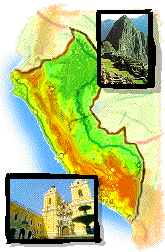
Introduction
 We
can assure your majesty that it is so beautiful and has such fine
buildings that it would even be remarkable in Spain.
We
can assure your majesty that it is so beautiful and has such fine
buildings that it would even be remarkable in Spain.
---Francisco
Pizarro, describing Cuzco in a letter to King Charles V of Spain.
Peru is South America's third largest
country, covering 1,285,215 sq. km., and can be divided into three
distinct geographic regions. The best known of these is the central high
sierra of the Andes, with its massive peaks, steep canyons, and
extraordinary pre Columbian archaeological sites. The Andes are still one
of the world's most unstable mountain ranges, with frequent earthquakes,
landslides, and flash floods. Despite such instability, the Andes are also
the site of the most fascinating pre-Columbian cities of South
America-like the great city of the clouds, Machu Picchu.
The Andes are by no means the only region to visit in Peru. Also of great
interest is Peru's narrow, lowland coastal region, a northern extension
of the Atacama Desert. Although the Atacama is generally known as the most
arid region on the planet, the climate along Peru's shores is made cooler
and less dry by La Garuła, a dense fog created by the collision of the
frigid waters of the Humboldt Current with the heated sands of the Atacama.
Lima, Trujillo, and Chiclayo, three of Peru's major population centres,
are located along this coastal desert.
Peru's third great region is the dense forest that surrounds the
headwaters of the Amazon beneath the eastern slopes of the Andes. This
part of the country is so inaccessible that only the most adventurous and
intrepid travelers should attempt to penetrate its mysterious emerald
depths. In fact, the region's capital of Iquitos, a city of 400,000, is
accessible only by air or by boat up the Amazon.
 Peru's
climate varies considerably by region, although January through March
tends everywhere to be the wet season. The coastal areas, which are quite
hot and humid during those months, are cooled during the rest of the year
by La Garuła. The fog doesn't penetrate very far inland, however, and the
western side of the Andes are very clear, warm, and dry for the greater
part of the year. As one moves up into the mountains, night-time
temperatures become considerably colder. The eastern slope of the Andes,
like the Amazon basin, experiences very heavy rainfall during the wet
season, which extends from January all the way through April.
Peru's
climate varies considerably by region, although January through March
tends everywhere to be the wet season. The coastal areas, which are quite
hot and humid during those months, are cooled during the rest of the year
by La Garuła. The fog doesn't penetrate very far inland, however, and the
western side of the Andes are very clear, warm, and dry for the greater
part of the year. As one moves up into the mountains, night-time
temperatures become considerably colder. The eastern slope of the Andes,
like the Amazon basin, experiences very heavy rainfall during the wet
season, which extends from January all the way through April.
Copyright (c) 1998 - 2005 Corp. All rights reserved.